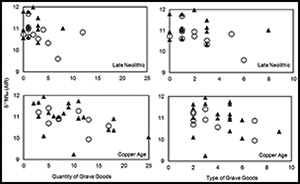Crossref Citations
This article has been cited by the following publications. This list is generated based on data provided by
Crossref.
2019.
Wind-Borne Illness from Coastal Seas.
p.
385.
Siklósi, Zsuzsanna
and
Szilágyi, Márton
2019.
New data on the provenance of copper finds from the Early-Middle Copper Age of the Great Hungarian Plain.
Archaeological and Anthropological Sciences,
Vol. 11,
Issue. 10,
p.
5275.
Toškan, Borut
Achino, Katia Francesca
and
Velušček, Anton
2020.
Faunal remains mirroring social and functional differentiation? The Copper Age pile-dwelling site of Maharski prekop (Ljubljansko barje, Slovenia).
Quaternary International,
Vol. 539,
Issue. ,
p.
62.
Gugora, Ariana
Dupras, Tosha L.
Fóthi, Erzsébet
and
Demény, Attila
2021.
New home, new diet? Reconstruction of diet at the 10th century CE Hungarian Conquest period site of Kenézlő-Fazekaszug from stable carbon and nitrogen isotope analyses.
Journal of Archaeological Science: Reports,
Vol. 38,
Issue. ,
p.
103033.
Voas, Maddeline R.
Killgrove, Kristina
Tykot, Robert H.
Nyárádi, Zsolt
Gonciar, Andre
and
Bethard, Jonathan D.
2021.
Childhood in the Carpathians: An isotopic analysis of childhood diet and weaning in a medieval and Early Modern Transylvanian village.
Journal of Archaeological Science: Reports,
Vol. 38,
Issue. ,
p.
103046.
Siklósi, Zsuzsanna
and
Szilágyi, Márton
2021.
CULTURE, PERIOD OR STYLE? RECONSIDERATION OF EARLY AND MIDDLE COPPER AGE CHRONOLOGY OF THE GREAT HUNGARIAN PLAIN.
Radiocarbon,
Vol. 63,
Issue. 2,
p.
585.
Faragó, Norbert
Gáll, Erwin
Gulyás, Bence
Marcsik, Antónia
Molnár, Erika
Bárány, Annamária
and
Szenthe, Gergely
2022.
Dietary and cultural differences between neighbouring communities: A case study on the early medieval Carpathian Basin (Avar and post-Avar period, 7th–9th/10th centuries AD).
Journal of Archaeological Science: Reports,
Vol. 42,
Issue. ,
p.
103361.
Siklósi, Zsuzsanna
Faragó, Norbert
Dani, János
Csedreki, László
Kertész, Zsófia
Szikszai, Zita
and
Szilágyi, Márton
2022.
Creating Histories: Different Perspectives, Controversial Narratives at Rákóczifalva, an Early Copper Age Site on the Great Hungarian Plain.
European Journal of Archaeology,
Vol. 25,
Issue. 3,
p.
350.
Depaermentier, M. L. C.
Kempf, M.
Bánffy, E.
and
Alt, K. W.
2025.
Cultural diversity shaped neolithic subsistence in the Carpathian Basin.
Scientific Reports,
Vol. 15,
Issue. 1,
